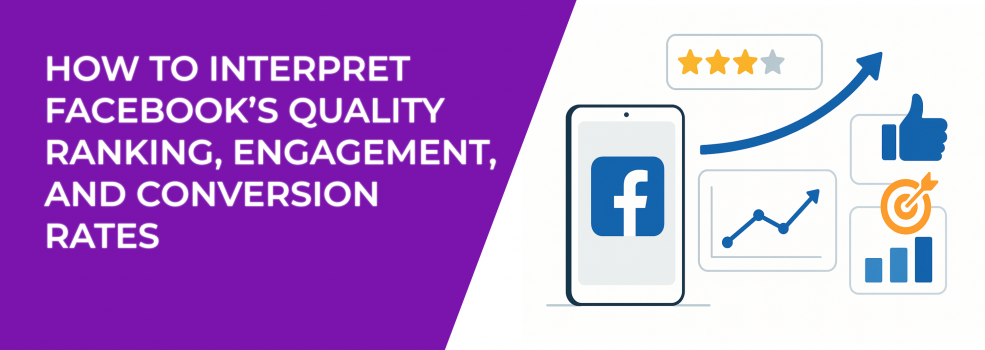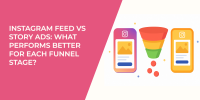Every time you run a Facebook ad, you're entering a silent auction. But it’s not just your bid that determines the winner. Behind the scenes, Facebook is scoring your ads based on how people react to them — how they engage, how they convert, and how relevant they seem.
These internal scores — Quality Ranking, Engagement Rate Ranking, and Conversion Rate Ranking — can make or break your campaign performance. Yet many advertisers overlook them or misinterpret what they actually mean.
Let’s go deeper than surface definitions. If you're spending time and money on Facebook or Instagram ads, you need to know how these rankings work — and how to use them to your advantage.
Quality Ranking: Measuring Perceived Value
What it is: Quality Ranking compares your ad’s perceived quality to others competing for the same audience. It’s not an absolute score — it’s relative. Facebook looks at things like user feedback (e.g., hides, negative reactions) and overall experience (ad relevance, landing page consistency).
A “Below Average” Quality Ranking means people are either skipping your ad or having a subpar experience with it — maybe both.
Why it matters: a lower score can directly increase your cost per result or limit delivery, even if your targeting is spot-on.
Actionable strategies to improve Quality Ranking:
-
Audit the full user journey. Ensure your ad copy, visuals, and landing page feel connected. If the ad promises simplicity and the page feels cluttered or slow, users bounce — and Facebook takes note.
-
Avoid clickbait headlines or misleading copy. Facebook penalizes ads that don’t match expectations. Instead of “You Won’t Believe What This Product Does,” try “Here’s How [Product] Cuts Your Prep Time in Half.”
-
Use native-style creative. Ads that blend into the feed — with casual language, natural lighting, and real-life context — often outperform polished promos. Try A/B testing professional vs. user-generated content to see which drives better response.
-
Track negative feedback. High hide or report rates signal poor ad quality. Watch your frequency — if people see the same ad too often, it leads to fatigue and negative actions.
Pro tip: use Facebook’s Post ID method to keep social proof (likes, shares, comments) intact across multiple ad sets — this can boost perceived quality over time.
Engagement Rate Ranking: Capturing Attention — and Holding It
What it is: Engagement Rate Ranking tells you how your ad’s expected engagement compares to others targeting the same audience. Engagement includes clicks, likes, shares, comments, saves, and more.
A poor ranking doesn’t just mean your ad is boring — it could signal a mismatch between the message and the audience, or a lack of compelling interaction.
Why it matters: higher engagement signals to Facebook that your ad is interesting or valuable — and you’ll often get better reach at a lower cost.
Strategies to increase Engagement Rate Ranking:
-
Write copy that sparks conversation.
Ask a relevant question. Use storytelling. Include specifics that your target audience will identify with. Instead of, “Shop our sale now,” try, “Struggling to stay focused in the afternoon? This 2-minute trick might help.” -
Design your ad for interaction.
Use carousel ads to encourage swiping, polls to invite feedback, or short-form video with captions to keep viewers engaged — especially on mute. -
Time your ads wisely.
Analyze when your audience is most active. Run engagement-optimized campaigns during peak hours to maximize visibility and momentum. -
Leverage social proof.
Reuse high-performing creatives that already have traction. People are more likely to interact when they see others engaging — it’s psychological validation. -
Use the first 3 seconds wisely.
In video, this is everything. Use motion, a question, or a problem-solution hook to keep users watching. If your video has a slow build-up, you’ll lose engagement fast.
Pro tip: don’t fall into the trap of chasing engagement for its own sake. Vanity metrics don’t always translate to conversions. Keep your CTA clear, even in highly interactive formats.
Not sure where to start with creative variations? What to Test First: Creative, Copy or Audience can help you prioritize your experiments.
Conversion Rate Ranking: Are You Driving Real Results?
What it is: Conversion Rate Ranking shows how well your ad is expected to drive results — purchases, leads, app installs — compared to similar ads. Facebook compares your conversion rates against competitors targeting similar audiences with similar optimization goals.
Why it matters: this score directly impacts your ad delivery efficiency. A higher Conversion Rate Ranking means better placement at a lower cost. A lower one? You’ll pay more and reach fewer people, even if everything else seems solid.
Concrete Ways to Boost Conversion Rate Ranking:
-
Match creative to funnel stage.
Don’t push for purchase if the user has never heard of you. Use remarketing for bottom-of-funnel conversions. Build trust at the top of the funnel with value-driven, educational content. -
Simplify your landing page.
-
Cut load time to under 3 seconds.
-
Make the CTA visible above the fold.
-
Eliminate distractions like excessive navigation or pop-ups.
-
Keep forms short — name, email, maybe one qualifier.
-
-
Test micro-conversions.
If you’re struggling to drive purchases, try optimizing for add-to-cart, landing page views, or newsletter signups to build momentum. Then retarget engaged users with stronger conversion intent. -
Build trust into the ad itself.
Add testimonials, review snippets, or use trust symbols like “30-day guarantee” or “1,000+ happy customers” in your ad copy or creative. This reduces friction and boosts intent. -
Use Dynamic Creative + CBO.
Let Facebook’s machine learning test combinations of headlines, images, and CTAs. Combine with Campaign Budget Optimization (CBO) to shift budget toward top converters automatically.
Pro tip: check bounce rate and time-on-site in Google Analytics or Meta Events Manager. Sometimes, a poor conversion ranking has more to do with post-click experience than ad quality.
When your clicks don’t turn into customers, the issue often isn’t the ad — it’s the offer. Facebook Ads Not Converting: How to Fix It outlines how to repair the funnel from click to close.
Reading and Using These Rankings Together
Think of these three metrics as a triangle. You can’t just focus on one — they inform each other.
-
A great ad with high engagement but low conversions? Maybe your landing page is confusing or doesn’t deliver on the ad’s promise.
-
A visually sharp ad with low engagement? You might be targeting the wrong audience or failing to offer a reason to interact.
-
A conversion-focused ad that never gets seen? Your quality score could be dragging delivery down before it even starts.
Here’s a step-by-step process to optimize using these scores:
-
Start by identifying your weakest ranking.
Facebook labels them as “Below Average,” “Average,” or “Above Average.” Prioritize fixing the lowest one first. -
Map each score to a specific issue.
-
Low Quality → Creative mismatch or poor user experience.
-
Low Engagement → Bland creative, wrong format, or misaligned messaging.
-
Low Conversion → Funnel friction, unclear CTA, or high offer resistance.
-
-
Test small, focused changes.
Don’t overhaul everything at once. Adjust headlines, swap images, or tweak your CTA — then watch how rankings shift. -
Use performance trends, not isolated results.
Look at score patterns over time, especially across different campaigns or audiences. What types of ads consistently perform better?
When you read these rankings together, not in isolation, you turn scattered feedback into a roadmap for smarter, faster campaign optimization.
Final Thoughts: Metrics as Strategy, Not Judgment
Facebook’s Quality, Engagement, and Conversion Rate rankings aren’t just data points — they’re windows into how your audience experiences your ads.
They reveal disconnects, confirm wins, and highlight blind spots. The key is to stop treating them as arbitrary scores and start using them as levers to refine your approach.
Want to scale profitably? Dig into these rankings. Diagnose the story behind the numbers. Experiment often but with a clear hypothesis every time.

